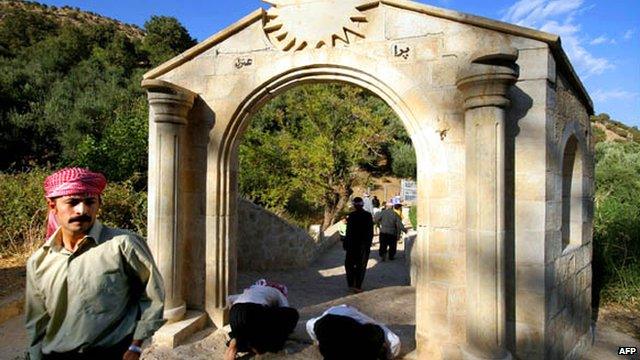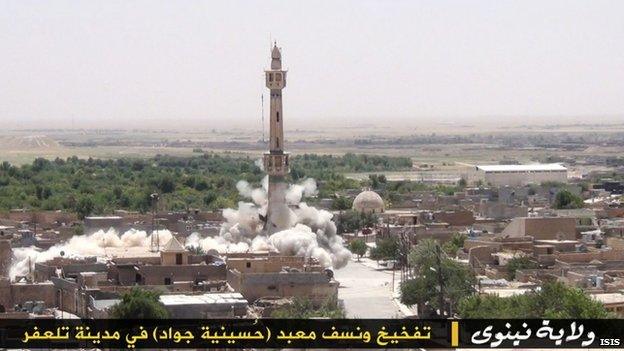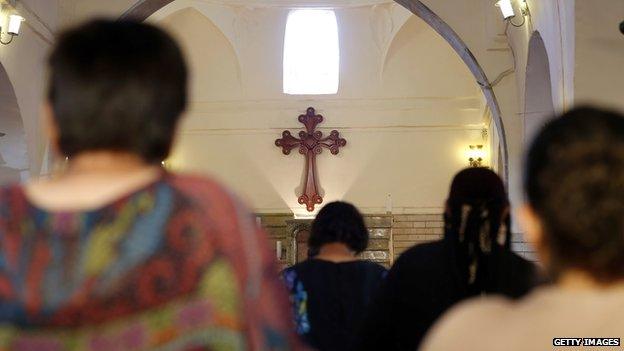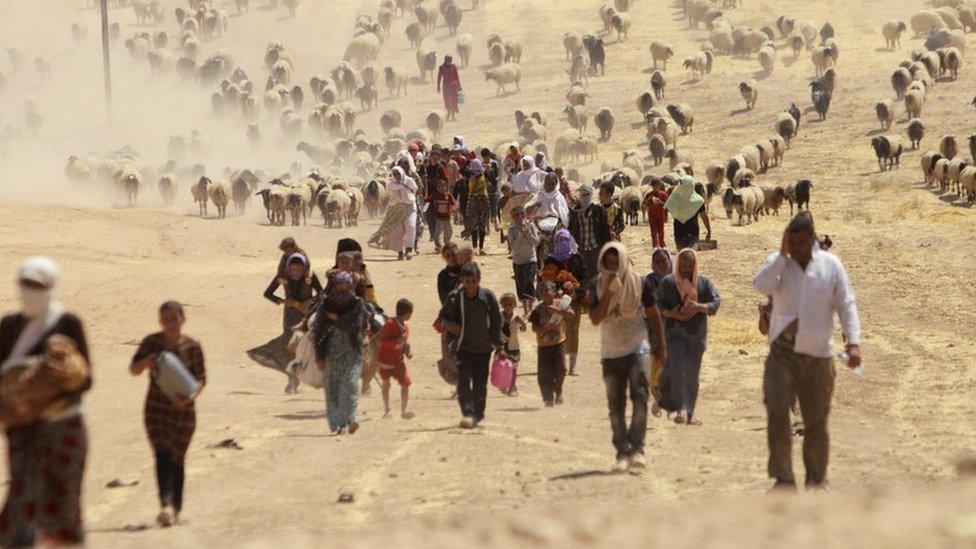Iraq: The minorities of Nineveh
- Published

A Yazidi temple in the Nineveh plains
The conflict in Iraq is often framed as a struggle between Shias and Sunnis and Arabs and Kurds - but the country is home to a number of minority groups who find themselves caught in the violence and in political bargains beyond their control.
Christians, Turkmen, Yazidis, Shabak, Sabian Mandaeans, Bahais, Kakais and Faili Kurds have lived in Iraq for a very long time - some for centuries, others for thousands of years.
Many of them, particularly Christians, Yazidis, Shabak and Turkemen, live in Nineveh, a culturally rich province 250 miles (400km) north-west of Baghdad. The area known as the Nineveh Plain, north-east of the province, is inhabited mostly by these minority groups.
Since the US-led invasion of 2003, Nineveh has been racked by two parallel conflicts - between the central government and extremist Islamist groups, and the central government and the autonomous Kurdish region.
Persecuted under the Ottomans, Saddam Hussein's Baathists and nowadays by jihadists, and facing prejudice and intolerance, some of the smaller minority groups, such as the Shabak and Yazidis, have led a life of secrecy.
This in turn has given rise to misconceptions and suspicions about them, and led to further persecutions.

Isis released this image of the destruction of a Shia mosque in Nineveh
With the takeover of Mosul, Nineveh's capital, on 10 June by the Islamic State (formerly known as Isis), the minorities in the city fled en masse to the villages in the Nineveh Plain or further north to Kurdish cities. Many of them took up arms alongside the Kurdish forces.
Since then, there has been a steady flow of reports of attacks carried out by the Islamists against minority groups and destruction of their places of worship. The Islamic State itself has posted pictures of dozens of historic and religious sites in Nineveh that it demolished, under the pretext that reverence of such sites is heretical.

The Minorities of Nineveh
Christians
Iraq's Christians are of diverse ethnicities and denominations, but the majority are Chaldo-Assyrians who have lived in the region for thousands of years.

Iraq's Christian population has plummeted in recent years
Their numbers have fallen from around 1.5 million in 2003 to 350,000-450,000. In Nineveh, they live mainly in the villages of Nineveh Plain, which include the Christian-dominant districts of Al-Hamdaniya (with its famous town of Qaraqosh) and Tel Kef.
One of the most devastating attacks targeting Iraqi Christians happened in 2010 when jihadists stormed a church in Baghdad during Sunday mass killing 52 people.

Yazidis
The Kurdish-speaking Yazidis are an ancient religious minority group that live in northern Iraq, particularly in the Nineveh Plain. A highly secretive group, their origins are subject of ongoing debates, although many consider them to be ethnic Kurds.

Many Iraqi Yazidis live in disputed territories
Their religion incorporates elements of many faiths, including Zoroastrian. As a result of some of their beliefs and the mystery surrounding their religion, many Muslims and non-Muslims have come to see Yazidis as devil worshippers.
This has led to violent attacks by Islamist groups who consider them infidels. In August 2007 jihadists attacked Yazidi villages in Nineveh, killing between 400 and 700 people.
There are estimated to be around 500,000 Yazidis today, most of them living in the Nineveh Plain in territories disputed between Arabs and Kurds.

Shabak
A minority group with its distinct language and customs, Shabaks are mostly Shia Muslims and a minority are Sunnis.
It is thought that today there are about 250,000-400,000 Shabaks, almost all in Nineveh.
Some Sunni extremists accuse the predominantly Shia Shabak of being an apostate offshoot of Islam, giving way to violent attacks against them.
Located in areas of disputed ownership between Kurdish and Arab Iraq, the Shabaks have often faced persecution as well as pressure to assimilate by both Arabs and Kurds.

Turkmen
The Turkmen are the third largest ethnic group in Iraq, after the Arabs and Kurds, estimated to number between half a million and 2.5 million.

Iraqi Turkmen people after fleeing to Kirkuk this month
They are mostly Muslim, roughly divided between the Sunni and Shia traditions. A minority are Catholics.
Turkmen have their own language and customs. They live mainly along the line between the Arab and Kurdish regions - in the provinces of Nineveh (mostly in Tal Afar), Kirkuk, Salaheddin and Diyala, but also in other parts of the country.
Often caught up in the power struggles between the Kurdish region and the central government and under Kurdish and Arab pressure to assimilate, they have also been the target of attacks by jihadists.
Following the Islamic State's takeover of Tal Afar in Nineveh, most of the town's 250,000 population fled to the Kurdish region.
BBC Monitoring, external reports and analyses news from TV, radio, web and print media around the world. For more reports from BBC Monitoring, click here. You can follow BBC Monitoring on Twitter , externaland Facebook, external.
- Published15 July 2014

- Published9 July 2014

- Published11 August 2014
